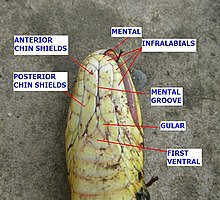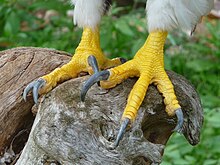Horn scales

As reptile scale is strongly called calloused skin areas with reptiles , birds and some fish and within the mammals in the pangolins . In some reptiles, they are also known as horn plates or horn shields .
Reptiles
In reptiles, the horn scales are called scuta ( lat. , Singular scutum ). They cover the entire body and are also important for the species - sometimes also for the sex determination. The reptile scales have an obliquely protruding cone-shaped protuberance of the cutis (cuticle papilla) on which a thickened and severely cornified epidermis lies. This leads to a tile-like overlap of neighboring scuta. In some species, skin bones are also embedded in the cutaneous papillae. In turtles, the horn scales also cover the bony belly and back armor . According to their location, the individual horn scales in scallops are called separately:
- on the head
- Ocularia ( Scuta ocularia , eye shields around the eye, further divided into the pre-, post-, supra- and suboculars)
- Supralabialia ( Scuta supralabialia , upper lip shields, along the upper edge of the mouth opening)
- Sublabialia ( Scuta sublabialia , lower lip shields , along the lower edge of the mouth opening)
- Nasalia ( Scuta nasalia , nasal shields, further subdivided into pre-, post-, internasals)
- Rostral ( Scutum rostrale , Schnauzenspitze)
- Loreale ( Scutum loreale , between Präocularia and Postnasalia)
- Parietalia ( Scuta parietalia , parietal shields )
- Temporalia ( Scuta temporalia , temple shields)
- on the body
- Ventralia ( Scuta ventralia , abdominal scales)
- Dorsalia ( Scuta dorsalia , dorsal scales)
- Vertebralia ( Scuta vertebralia , median dorsal scales)
- on the tail
- Anale , actually Scutum anale (anal shield, in the area of the cloaca)
- Subcaudalia ( Scuta subcaudalia , underside of the tail)
The snake scales are discussed in detail in the article Snake Scaling.
Birds
In birds, horn scales are mainly found on the foot , i.e. in areas that are not feathered. This area of skin is also known as the podotheca . These are heavily keratinized areas of skin that are separated from neighboring scales by less keratinized furrows. The individual scales are called “shields” (Latin Scutella , diminutive of Scutum ).
Pangolins
The scales of the pangolins sit on protuberances of the dermis that are bent backwards, like those of scale creeps. In cross-section it consists of three layers: The upper dorsal plate (back plate) consists of flattened, severely cornified cells. The intermediate plate is formed by less flattened, keratinized cells. The ventral plate (belly plate) forms the underside of the scale and is only a few cell layers thick. All three plates are formed from different epidermal germinal areas. The scales of the pangolins, in contrast to those of the pangolin, grow steadily and thus resemble the fingernails of primates most closely.
Individual evidence
- ^ Gerhard Czihak, H. Langer, H. Ziegler: Biology: A textbook . Springer-Verlag, 6th edition 2013, ISBN 9783642852640 , p. 522.
- ^ Franz-Viktor Salomon and Maria-Elisabeth Krautwald-Junghanns: Anatomy of the birds. In: Franz-Viktor Salomon et al. (Hrsg.): Anatomie für die Tiermedizin. 3., Stuttgart 2015, ISBN 978-3-8304-1288-5 , p. 811.
- ^ RIC Spearman: On the structure of the horny scales of the pangolin. In: Journal of the Linnean Society (Zoology) 46 (310), 1967; Pp. 267-273



